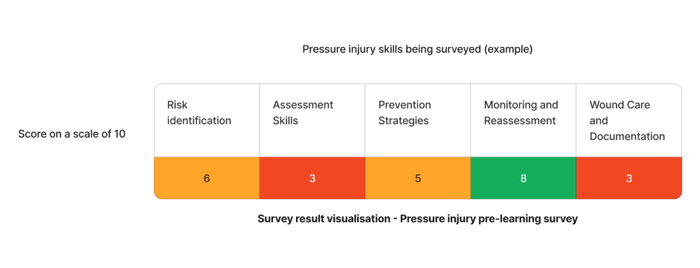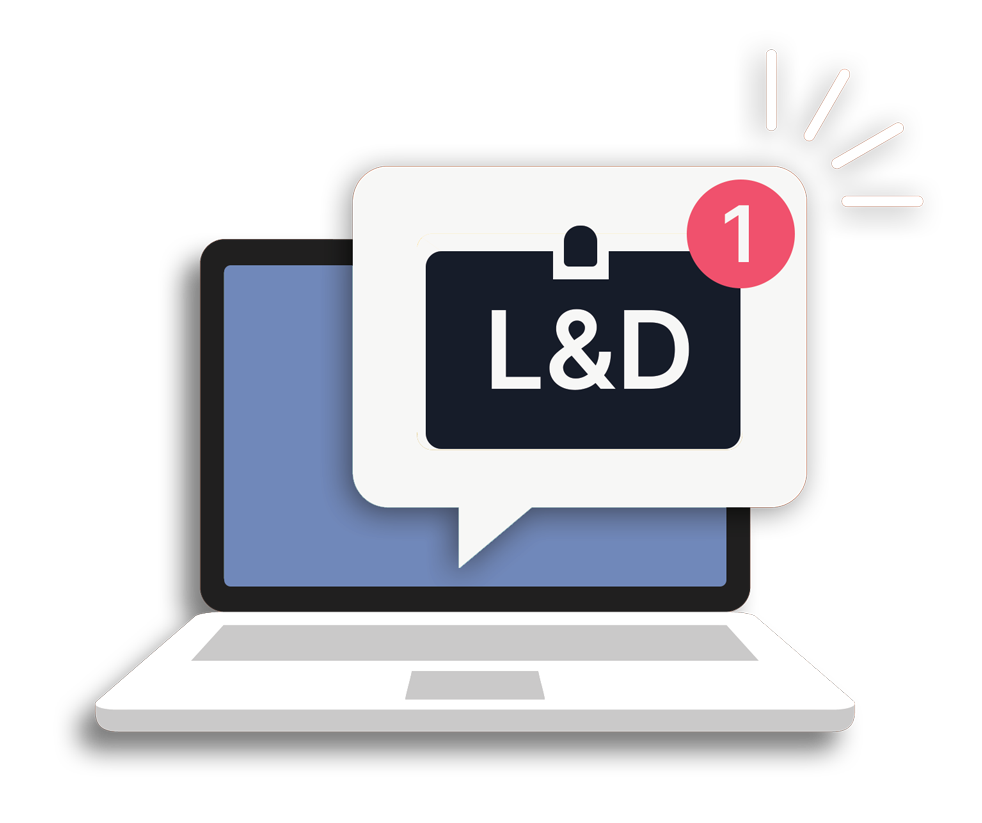This article is part of our Training Requirement Series where we provide comprehensive guides to meet the actual training requirements that are often needed/requested of learning and development departments within Australia's healthcare organisations. This series includes both general requirements, such as pressure injury prevention and management, but also focuses on the specific requirements stemming from the NDIS, Aged Care and NSQHS Quality Standards.
What are Pressure Injuries?
Pressure injuries are localised areas of damage to the skin and underlying tissues, usually over bony prominences or related to medical or other devices. They occur primarily as a result of prolonged pressure or pressure in combination with shear. The injuries can present in various stages, ranging from a mild red area that disappears after pressure is relieved, to severe forms involving deep tissue necrosis, exposing muscle and bone. These injuries can lead to life-threatening complications such as infections.
Why is Pressure Injury Training Important?
Not only is pressure injury prevention and management important in terms of enhancing patient outcomes and supporting an elevated quality of life, early intervention gto prevent pressure injuries is likely to result in significant cost-savings within hospital settings (Nghiem, et. al 2022)
What is the Pressure Injuries Training Requirement?
The training needs for pressure injury prevention and management are clearly delineated in several healthcare standards and guidelines. According to NSQHS Actions 5.21, 5.22, and 5.23, healthcare organisations are required to provide ongoing training on the risk assessment of pressure injuries and their management. Similarly, the Strengthened Aged Care Standards 5.7.4 (c) emphasise the need for training in aged care settings (notably at end-of-life). Effective training is not merely a checkbox to meet regulatory demands; it is a cornerstone for enhancing patient safety and care quality.
Relevant Standards
Action 5.21: Pressure injury prevention and wound management systems
Organisations providing services should:
- Adapt or develop wound management systems based on best-practice guidelines
- Use screening and assessment information to prevent and manage pressure injuries
- Deisgnate individual or groups that are responsible to oversee the system
Action 5.22: Comprehensive skin inspections
- Adapt or develop processes that facilitate clinicians to perform and document comprehensive skin inspections as part of routine patient care
- a) Information about preventing pressure injuries are communicated to patients, carers and families
- b) Best-practice guidelines are followed when using pressure injury equipment, products, and devices
National Safety and Quality Health Service (NSQHS) Standards
Action 5.7.4: End-of-life care:
- c) provide pressure care, oral care, eye care and bowel and bladder care
Strengthened Quality Standards framework analysis - Aged Care Quality Standards
Failure to comply with the requirements could lead to an organisation being penalised or reprimanded.
Pressure Injury Skills Required for Healthcare Staff
For effective prevention and management of pressure injuries, healthcare staff should be proficient in the following skills:
| Skill | Key Elements |
|---|---|
| Risk Identification |
Staff should be competent in identifying patients who are at high risk for developing pressure injuries, taking into account factors like immobility, nutritional status, and comorbidities. |
| Assessment Skills |
Utilising recognised tools such as the Braden Scale or Norton Scale for assessing pressure injury risk is crucial. Staff should be trained in performing comprehensive skin assessments, focusing on bony prominences and areas under medical devices. |
| Implementation of Preventive Strategies |
Staff should be capable of selecting and employing appropriate preventive measures, such as pressure-relieving mattresses, cushions, and regular patient repositioning, tailored to each patient's specific needs. |
| Monitoring and Reassessment |
Regular surveillance for signs of pressure injuries and effectiveness of preventive measures should be conducted. This involves both visual inspections and palpation techniques to identify any hidden or deep-tissue injuries. |
| Wound Care and Documentation |
Staff should be proficient in both basic and advanced wound care techniques, including but not limited to dressing changes, use of appropriate wound care products, and documenting each step carefully for future reference and continuous care. |
How to Assess Staff Competency in Pressure Injuries
It's vital to have a comprehensive evaluation framework for assessing the competency of healthcare staff in pressure injuries prevention and management. The evaluation can be twofold:
- Theoretical Assessments: These can include written exams featuring multiple-choice questions, true/false questions, and even short essay-type questions that simulate real-life scenarios. Staff should be required to demonstrate in-depth knowledge of the various stages of pressure injuries, risk factors, and appropriate preventive and therapeutic measures.
- Practical Assessments: Practical skills can be evaluated through observed structured clinical examinations (OSCEs), where staff are observed while performing tasks like risk assessment, patient positioning, and wound dressing. Objective criteria should be set for each skill, and checklists can be used for evaluation.
Strategies to Support Healthcare Staff Improve Pressure Injury Skills
Once the training needs and competency levels are identified, the next step is skill development. Here are some strategies to foster staff skills:
- Regular Workshops: Practical skills are best learned through doing. Regular workshops can provide staff with the opportunity to practise their skills in a safe and supervised environment.
- Peer Reviews: Peer reviews offer an additional layer of quality check and provide valuable feedback for continuous improvement. Staff can be paired up to observe, critique, and learn from each other.
- Online Learning Modules: Online resources can act as supplementary material that staff can refer to for brushing up their theoretical knowledge, thus reinforcing what they learn in hands-on training sessions.
- Performance Metrics: Use of performance metrics can offer objective data to evaluate the effectiveness of training programmes, providing insights for further improvement.
Sample Training Plan for the Pressure Injuries Training Requirement
Ensuring staff are competent in pressure injury prevention and management is vital for your organisation to remain compliant to the Standards. Below is an sample training plan that aligns with Australian standards such as the Aged Care Standards, and NSQHS - based on a mock competency assessment survey.

Using the above image as an example - The skills that requires the most attention are observation and technical skills. We can target learning initiatives to fill these gaps to drive clinical staff competency.
| Quarter | Topics | Resources |
|---|---|---|
| Q1 | Assessment Skills | |
| Q2 | Wound Care and Documentation |
|
Need an LMS that can support this training requirement
Contact Ausmed today and see how we can support with your pressure injury requirements (and more)!
Staff Competency Assessment for Pressure Injuries - Example
The following is an example survey that learning and development coordinators may use to asses staff competency on clinical assessment.
Staff Survey - Pressure Injury Competency
-
How would you assess a patient's risk for developing a pressure injury?
- [Answer here]
-
Name two types of pressure-relieving devices used in your practice.
- [Answer here]
-
What frequency of patient repositioning do you recommend for high-risk patients?
- [Answer here]
-
How would you document a newly discovered pressure injury?
- [Answer here]
-
Describe the steps you would take to manage an existing stage II pressure injury.
- [Answer here]
Conclusion
In summary, effective training in the prevention and management of pressure injuries is not only a regulatory requirement but a moral obligation to ensure the well-being of patients. By adhering to NSQHS and Aged Care Standards, implementing a comprehensive training programme, and regularly assessing staff competency, healthcare organisations can substantially mitigate the risk and impact of pressure injuries.
References
- Nghiem, S. Campbell, J. Walker, RM. Byrnes, J. Chaboyer, W. ScienceDirect, 2022. 'Pressure injuries in Australian public hospitals: A cost of illness study'
- Australian Commission on Safety and Quality in Health, 2023. 'NSQHS Comprehensive Care Standard'
- Australian Commission on Safety and Quality in Health, 2023. 'NSQHS Action 5.21 - Preventing and managing pressure injuries'
- Australian Commission on Safety and Quality in Health, 2023. 'NSQHS Action 5.22 - Preventing and managing pressure injuries'
- Australian Commission on Safety and Quality in Health, 2023. 'NSQHS Action 5.23 - Preventing and managing pressure injuries'
- Aged Care Quality and Safety Commission, 2023. 'Stronger Standards, Better Aged Care Program - 5.7.4 (c)


